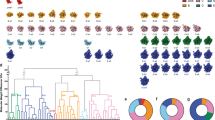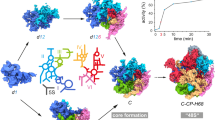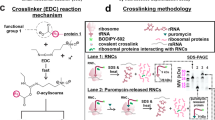Abstract
Self-assembling macromolecular machines drive fundamental cellular processes, including transcription, messenger RNA processing, translation, DNA replication and cellular transport. The ribosome, which carries out protein synthesis, is one such machine, and the 30S subunit of the bacterial ribosome is the preeminent model system for biophysical analysis of large RNA–protein complexes. Our understanding of 30S assembly is incomplete, owing to the challenges of monitoring the association of many components simultaneously. Here we have developed a method involving pulse–chase monitored by quantitative mass spectrometry (PC/QMS) to follow the assembly of the 20 ribosomal proteins with 16S ribosomal RNA during formation of the functional particle. These data represent a detailed and quantitative kinetic characterization of the assembly of a large multicomponent macromolecular complex. By measuring the protein binding rates at a range of temperatures, we find that local transformations throughout the assembling subunit have similar but distinct activation energies. Thus, the prevailing view of 30S assembly as a pathway proceeding through a global rate-limiting conformational change must give way to one in which the assembly of the complex traverses a landscape dotted with various local conformational transitions.
This is a preview of subscription content, access via your institution
Access options
Subscribe to this journal
Receive 51 print issues and online access
$199.00 per year
only $3.90 per issue
Buy this article
- Purchase on Springer Link
- Instant access to full article PDF
Prices may be subject to local taxes which are calculated during checkout





Similar content being viewed by others
References
Wimberly, B. T. et al. Structure of the 30S ribosomal subunit. Nature 407, 327–339 (2000)
Schluenzen, F. et al. Structure of functionally activated small ribosomal subunit at 3.3 Å resolution. Cell 102, 615–623 (2000)
Brodersen, D. E., Clemons, W. M. Jr, Carter, A. P., Wimberly, B. T. & Ramakrishnan, V. Crystal structure of the 30 S ribosomal subunit from Thermus thermophilus: structure of the proteins and their interactions with 16 S RNA. J. Mol. Biol. 316, 725–768 (2002)
Moazed, D., Stern, S. & Noller, H. F. Rapid chemical probing of conformation in 16 S ribosomal RNA and 30 S ribosomal subunits using primer extension. J. Mol. Biol. 187, 399–416 (1986)
Agalarov, S. C. & Williamson, J. R. A hierarchy of RNA subdomains in assembly of the central domain of the 30 S ribosomal subunit. RNA 6, 402–408 (2000)
Powers, T., Daubresse, G. & Noller, H. F. Dynamics of in vitro assembly of 16 S rRNA into 30 S ribosomal subunits. J. Mol. Biol. 232, 362–374 (1993)
Recht, M. I. & Williamson, J. R. Thermodynamics and kinetics of central domain assembly. Cold Spring Harbor Symp. Quant. Biol. 66, 591–598 (2001)
Stagg, S. M., Mears, J. A. & Harvey, S. C. A structural model for the assembly of the 30S subunit of the ribosome. J. Mol. Biol. 328, 49–61 (2003)
Stern, S., Powers, T., Changchien, L. M. & Noller, H. F. RNA–protein interactions in 30S ribosomal subunits: folding and function of 16S rRNA. Science 244, 783–790 (1989)
Held, W. A., Ballou, B., Mizushima, S. & Nomura, M. Assembly mapping of 30 S ribosomal proteins from Escherichia coli. J. Biol. Chem. 249, 3103–3111 (1974)
Culver, G. M. Assembly of the 30S ribosomal subunit. Biopolymers 68, 234–249 (2003)
Traub, P. & Nomura, M. Structure and function of Escherichia coli ribosomes VI. Mechanism of assembly of 30 S ribosomes studied in vitro. J. Mol. Biol. 40, 391–413 (1969)
Held, W. A. & Nomura, M. Rate-determining step in the reconstitution of Escherichia coli 30S ribosomal subunits. Biochemistry 12, 3273–3281 (1973)
Holmes, K. L. & Culver, G. M. Mapping structural differences between 30S ribosomal subunit assembly intermediates. Nature Struct. Mol. Biol. 11, 179–186 (2004)
Gygi, S. P. et al. Quantitative analysis of complex protein mixtures using isotope-coded affinity tags. Nature Biotechnol. 17, 994–999 (1999)
Oda, Y., Huang, K., Cross, F. R., Cowburn, D. & Chait, B. T. Accurate quantitation of protein expression and site-specific phosphorylation. Proc. Natl Acad. Sci. USA 96, 6591–6596 (1999)
Pasa-Tolic, L. et al. High throughput proteome-wide precision measurements of protein expression using mass spectrometry. J. Am. Chem. Soc. 121, 7949–7950 (1999)
Sechi, S. & Oda, Y. Quantitative proteomics using mass spectrometry. Curr. Opin. Chem. Biol. 7, 70–77 (2003)
Traub, P. & Nomura, M. Structure and function of E. coli ribosomes. V. Reconstitution of functionally active 30S ribosomal particles from RNA and proteins. Proc. Natl Acad. Sci. USA 59, 777–784 (1968)
Beavis, R. C. & Chait, B. T. Matrix-assisted laser desorption ionization mass-spectrometry of proteins. Methods Enzymol. 270, 519–551 (1996)
Hillenkamp, F. & Karas, M. Mass spectrometry of peptides and proteins by matrix-assisted ultraviolet laser desorption/ionization. Methods Enzymol. 193, 280–295 (1990)
Jennings, K. R. & Dolnikowski, G. G. Mass analyzers. Methods Enzymol. 193, 37–61 (1990)
Pichon, J., Marvaldi, J. & Marchis-Mouren, G. The in vivo order of protein addition in the course of Escherichia coli 30 S and 50 S subunit biogenesis. J. Mol. Biol. 96, 125–137 (1975)
Mangiarotti, G., Apirion, D., Schlessinger, D. & Silengo, L. Biosynthetic precursors of 30S and 50S ribosomal particles in Escherichia coli. Biochemistry 7, 456–472 (1968)
Srivastava, A. K. & Schlessinger, D. in The Ribosome: Structure, Function, & Evolution (ed. Hill, W. et al.) 426–434 (American Society of Microbiology, Washington DC, 1990)
Xia, T. et al. Thermodynamic parameters for an expanded nearest-neighbour model for formation of RNA duplexes with Watson–Crick base pairs. Biochemistry 37, 14719–14735 (1998)
Dill, K. A. & Chan, H. S. From Levinthal to pathways to funnels. Nature Struct. Biol. 4, 10–19 (1997)
Pan, J., Thirumalai, D. & Woodson, S. A. Folding of RNA involves parallel pathways. J. Mol. Biol. 273, 7–13 (1997)
Rook, M. S., Treiber, D. K. & Williamson, J. R. Fast folding mutants of the Tetrahymena group I ribozyme reveal a rugged folding energy landscape. J. Mol. Biol. 281, 609–620 (1998)
Thirumalai, D. & Woodson, S. A. Kinetics of folding of proteins and RNA. Acc. Chem. Res. 29, 433–439 (1996)
Nomura, M. Assembly of bacterial ribosomes. Science 179, 864–873 (1973)
Alix, J. H. & Guerin, M. F. Mutant DnaK chaperones cause ribosome assembly defects in Escherichia coli. Proc. Natl Acad. Sci. USA 90, 9725–9729 (1993)
Maki, J. A., Schnobrich, D. J. & Culver, G. M. The DnaK chaperone system facilitates 30S ribosomal subunit assembly. Mol. Cell 10, 129–138 (2002)
Maki, J. A., Southworth, D. R. & Culver, G. M. Demonstration of the role of the DnaK chaperone system in assembly of 30S ribosomal subunits using a purified in vitro system. RNA 9, 1418–1421 (2003)
Serdyuk, I. N., Agalarov, S. C., Sedelnikova, S. E., Spirin, A. S. & May, R. P. Shape and compactness of the isolated ribosomal 16 S RNA and its complexes with ribosomal proteins. J. Mol. Biol. 169, 409–425 (1983)
Culver, G. M. & Noller, H. F. Efficient reconstitution of functional Escherichia coli 30S ribosomal subunits from a complete set of recombinant small subunit ribosomal proteins. RNA 5, 832–843 (1999)
Acknowledgements
We thank the staff of the TSRI Center for Mass Spectrometry for assistance with mass spectrometry; M. I. Recht, S. C. Agalarov and S. P. Ryder for discussions and technical assistance; the laboratories of D. B. Goodin, S. P. Mayfield and A. Schneemann for use of equipment; and M. J. Fedor, J. D. Puglisi and S. P. Ryder for critically reading the manuscript. This work was supported by a grant from the NIH (to J.R.W.) and by predoctoral fellowships from the NSF and the Skaggs Institute for Chemical Biology (to M.W.T.T.). Author Contributions The experimental work in this manuscript was carried out by M.W.T.T., with advice and support from G.S. and J.R.W.
Author information
Authors and Affiliations
Corresponding author
Ethics declarations
Competing interests
Reprints and permissions information is available at npg.nature.com/reprintsandpermissions. The authors declare no competing financial interests.
Supplementary information
Supplementary Methods
Additional details of the methods used in this study. This file also contains additional references. (DOC 105 kb)
Supplementary Table S1
30S protein binding rates determined by PC/QMS at a range of temperatures and the resulting binding activation energies. (DOC 120 kb)
Supplementary Figure S1
Binding progress curves from PC/QMS and gel mobility shift for the S15:A4 model system. (PDF 2513 kb)
Supplementary Figure S2
30S protein binding progress curves from PC/QMS under standard conditions (as in Fig. 2a). Here the progress curves for the different proteins are shown (PDF 3321 kb)
Supplementary Figure S3
Arrhenius plots of the protein binding rates determined by PC/QMS at a range of temperatures (as in Fig. 4b). Here the Arrhenius plots for the different proteins are shown separately. (PDF 3878 kb)
Rights and permissions
About this article
Cite this article
Talkington, M., Siuzdak, G. & Williamson, J. An assembly landscape for the 30S ribosomal subunit. Nature 438, 628–632 (2005). https://doi.org/10.1038/nature04261
Received:
Accepted:
Issue Date:
DOI: https://doi.org/10.1038/nature04261
This article is cited by
-
In vitro reconstitution of functional small ribosomal subunit assembly for comprehensive analysis of ribosomal elements in E. coli
Communications Biology (2020)
-
Real-time assembly of ribonucleoprotein complexes on nascent RNA transcripts
Nature Communications (2018)
-
Evolution of protein-coupled RNA dynamics during hierarchical assembly of ribosomal complexes
Nature Communications (2017)
-
Functional characterization of chloroplast-targeted RbgA GTPase in higher plants
Plant Molecular Biology (2017)
-
Involvement of human ribosomal proteins in nucleolar structure and p53-dependent nucleolar stress
Nature Communications (2016)
Comments
By submitting a comment you agree to abide by our Terms and Community Guidelines. If you find something abusive or that does not comply with our terms or guidelines please flag it as inappropriate.



